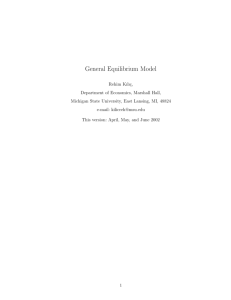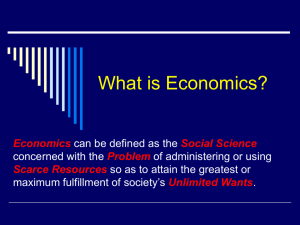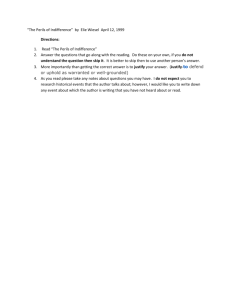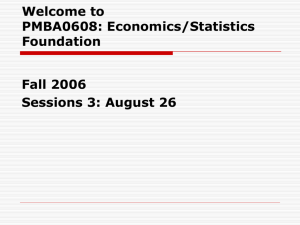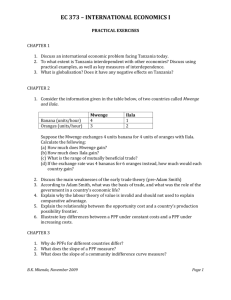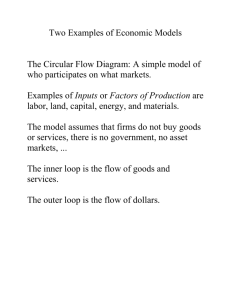International Trade Theory: Increasing Costs & Gains from Trade
advertisement
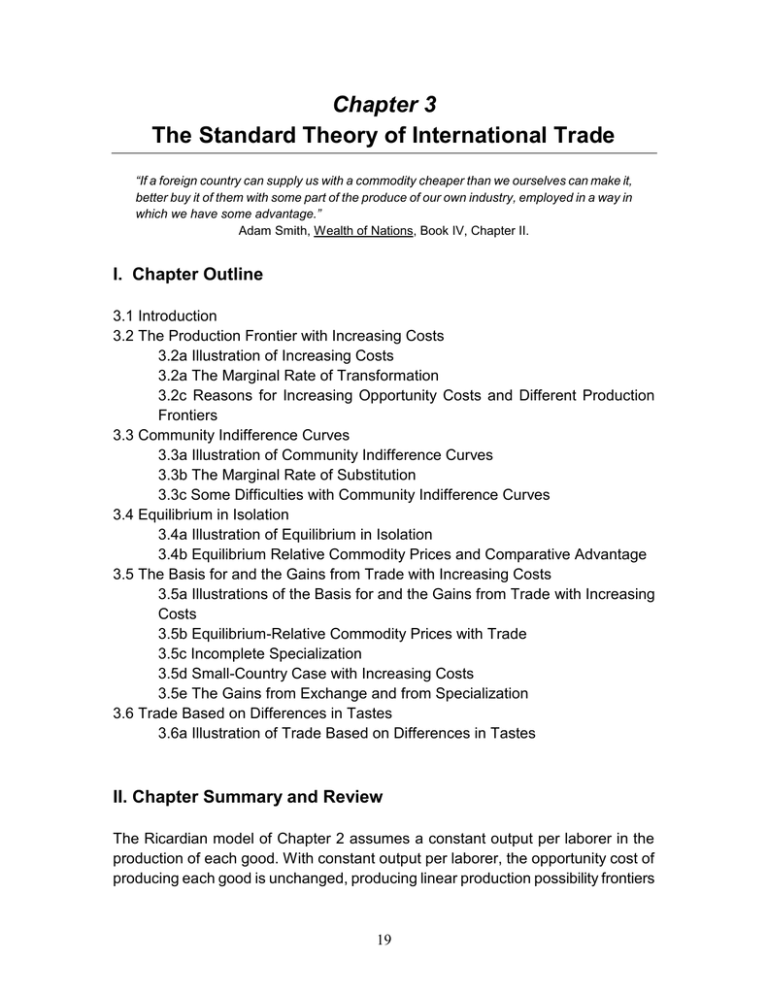
Chapter 3 The Standard Theory of International Trade “If a foreign country can supply us with a commodity cheaper than we ourselves can make it, better buy it of them with some part of the produce of our own industry, employed in a way in which we have some advantage.” Adam Smith, Wealth of Nations, Book IV, Chapter II. I. Chapter Outline 3.1 Introduction 3.2 The Production Frontier with Increasing Costs 3.2a Illustration of Increasing Costs 3.2a The Marginal Rate of Transformation 3.2c Reasons for Increasing Opportunity Costs and Different Production Frontiers 3.3 Community Indifference Curves 3.3a Illustration of Community Indifference Curves 3.3b The Marginal Rate of Substitution 3.3c Some Difficulties with Community Indifference Curves 3.4 Equilibrium in Isolation 3.4a Illustration of Equilibrium in Isolation 3.4b Equilibrium Relative Commodity Prices and Comparative Advantage 3.5 The Basis for and the Gains from Trade with Increasing Costs 3.5a Illustrations of the Basis for and the Gains from Trade with Increasing Costs 3.5b Equilibrium-Relative Commodity Prices with Trade 3.5c Incomplete Specialization 3.5d Small-Country Case with Increasing Costs 3.5e The Gains from Exchange and from Specialization 3.6 Trade Based on Differences in Tastes 3.6a Illustration of Trade Based on Differences in Tastes II. Chapter Summary and Review The Ricardian model of Chapter 2 assumes a constant output per laborer in the production of each good. With constant output per laborer, the opportunity cost of producing each good is unchanged, producing linear production possibility frontiers 19 International Economics, Tenth Edition Study Guide (ppfs). In this chapter a degree of realism is added by introducing increasing opportunity costs. Increasing opportunity cost reflects the idea that increased production of a good becomes increasingly difficult (more costly per unit), because resources are not identical. As resources are continually shifted from, say, Good Y to Good X, those resources that remain in the production of Y are less suited for production of X than those first transferred. Producing the next unit of Good X will require a substantial loss of Y. As more of Good X is produced, the opportunity cost of producing Good X increases. The slope of the ppf in Fig. 3.1 is Y/ X, and is the opportunity cost of a unit of good X, as introduced in Chapter 2. In the presence of increasing opportunity costs, the ppf will get steeper ( Y/ X will increase in absolute value) as more X is produced. Starting at point a in Fig. 3.1, notice that in order to increase the production of good X by one unit, only one unit of Y is foregone. The opportunity cost of X is one unit of Y, or Y/ X is 1 in the vicinity of point a. Starting at point b, two units of Y must be foregone in order to get one unit of good X, so Y/ X = 2. A concave from the origin (bowed out from the origin) ppf illustrates higher opportunity cost at higher levels of production. (Note this applies for higher levels of both goods. As Y increases and X decreases, the opportunity cost of Y increases.) Figure 3.1 Y a Y=1 X=1 b Y=2 X=1 X The absolute value of the slope of the ppf is also called the marginal rate of transformation. To avoid confusion you might find it useful to write MRT y/x to mean the rate at which good Y can be transformed into good X. If MRT y/x = 2, then two units of good Y must be sacrificed to get one unit of good X. The ppf indicates possible levels of production. Where a nation chooses to consume along a ppf depends upon the nation's preferences for goods, which are 20 Chapter 3 / The Law of Comparative Advantage shown with community indifference curves. A community indifference curve for goods X and Y traces out all the combinations of goods X and Y that produce the same level of community satisfaction (or synonymously, well-being, utility, standard of living, or welfare). An indifference curve indicates one level of satisfaction. For example, points d and e in Fig. 3.2 are on one indifference curve so the two combinations of goods X and Y given by the points d and e produce the same level of satisfaction. Figure 3.2 Y d f e h III II I X Given a community's set of indifference curves (preference map), as in Fig. 3.2, all combinations of goods Y and X can be ranked. Indifference curves to the right (or above) indicate higher levels of satisfaction. For example, because point f lies on a higher indifference curve than point e, the combinations of goods indicated by point f is preferred to that combination indicated by point e. Of course, point f shows more Y and more X, so the superiority of point f is apparent if more goods are preferred to fewer goods. Where indifference curves become more useful is in less obvious comparisons. Point h, for example has less of good Y and more of good X than point e, so it is not immediately apparent which is the preferred combination. However, if the indifference curves in Fig. 3.2 do indeed indicate the community's preferences, then point h is superior to point e because point h is on a higher indifference curve. The slope of the indifference curve is the amount of Y that the community will give up in exchange for more X without affecting community welfare, and (in absolute value) is called the marginal rate of substitution. As with the marginal rate of transformation, it may be useful to write MRSy/x to indicate the units of Y that 21 International Economics, Tenth Edition Study Guide the community will give up for X, with no change in community welfare. If MRSy/x = 3/2, then if three units of good Y are lost, and two units of good X are gained, there will be no change in community welfare. Indifference curves are drawn flatter as less Y and more X is consumed (graphically moving left to right), reflecting the assumption that as more of X is consumed, each additional unit becomes worth less to consumers, and as less of Y is consumed, each additional unit becomes worth more to consumers. That would mean that as more X is consumed, more and more of X must be added to make up for the loss of Y. This produces a flatter indifference curve as more X is consumed; the MRSy/x falls as consumption of X is increased. Combining the ppf with community indifference curves shows the unique combination of goods that will maximize welfare for a nation in the absence of trade. The absence of trade, or economic isolation, is also known as autarky. Given a ppf, the highest level of satisfaction that the nation can achieve (maximum welfare) is shown by a tangency between the community indifference curve and the ppf. If the indifference curve and ppf intersect, then there is necessarily a higher indifference curve that can be achieved with a given ppf. Such a tangency is shown in Fig. 3.3. At point A in Fig. 3.3, community satisfaction is maximized because the highest possible indifference curve for the existing ppf is reached. Thus, in the absence of trade, maximum welfare occurs where MRTy/x = MRSy/x. Figure 3.3 Y A III II |slope|=PX/PY I X At the pre-trade equilibrium, the relative price of goods Y and X can be indicated by the slope (in absolute value) of a straight line that is tangent to where 22 Chapter 3 / The Law of Comparative Advantage the ppf and the community indifference curve are tangent. The reason why the slope of the line indicates the relative price is because at that point there is a unique opportunity cost of X, as measured by the slope of the production possibility frontier (ppf). In the long run, competitive markets will bid the price of a good down to its opportunity cost. If the slope of the ppf at point A is the opportunity cost of X, then it is the price of X. More precisely, the slope of the ppf at A is the opportunity cost of X, measured in Y, so it is the price of X, relative to Y. It is crucial for much of the analysis in this and subsequent chapters that this point be understood; review it carefully. If the opportunity cost of X is, say, 2, then it takes two units of Y to get one unit of X, so X must cost twice as much as Y, i.e., Px/Py = 2/1. Thus, Y/ X = Px/Py. Once pre-trade relative prices are established, as in Fig. 3.3, then the explanation of the benefits of international trade is relatively simple. Suppose that the pre-trade relative prices for two countries differ, i.e., (Px/Py)1<(Px/Py)2, where the subscripts refer to Nations 1 and 2. Nation 1 has a comparative advantage in good X because it has a lower relative price of X (or equivalently, a lower opportunity cost of X). This implies that Nation 2 has the comparative advantage in good Y because inverting the inequality produces (Py/Px)1>(Py/Px)2. Because relative prices differ between the two countries, trade can be mutually beneficial. Nation 1 with a low relative price of producing Good X can export Good X to Nation Y with a high relative price of producing Good X. If the relative price of Good X lies in between Nation 1’s low price and Nation 2’s high price, then producers in Nation 1 will gain through exporting Good X and consumers in Nation 2 will gain by importing Good X. The same analysis applies to the exports of Good Y by Nation 2 and the imports of Good Y by Nation 1. Be sure you can explain why both nations can gain on both the consumption and production side. Due to increasing opportunity cost, as Nation 1 produces more of Good X to export to Nation 2, the price of Good X will increase, and as Nation 2 produces less of Good X, the price of Good X will decrease (increasing opportunity cost applies in reverse: as less is produced the cost of production falls). The price at which trade takes place -the terms of trade- will lie in between the pre-trade relative prices of the two countries. Recall that trade will benefit a nation if the terms of trade differ from domestic opportunity cost, and domestic opportunity cost equals relative prices. 23 International Economics, Tenth Edition Study Guide We can conclude that if pre-trade relative prices differ between countries, trade can produce gains for both countries. Pre-trade relative prices will differ if ppfs are identical but preference maps differ, or if preference maps are identical but ppfs differ, or if both different ppfs and different preference maps produce different pretrade relative prices. III. Questions 1. a) Consider a country in isolation (autarky), producing where MRTY/X exceeds the MRSY/X. a) Show this graphically, using a community indifference curve and an increasing cost ppf as introduced in this chapter. b) Should the country produce more of good X or more of good Y? c) What will happen to the MRT and the MRS as a result of producing more of the good that you indicated in part b)? 2. The pre-trade equilibria of Nations 1 and 2 are shown in Fig. 3.4. Figure 3.4 Y Y A’ A Nation 1 X Nation 2 a) Based on Fig. 3.4, which is the correct inequality? (PX/PY)1 > or < (PX/PY)2? 24 X Chapter 3 / The Law of Comparative Advantage b) What is the range of possible terms of trade, expressed in relative prices, at which both countries will gain from trade? c) Given favorable terms of trade, in which good will Nation 1 specialize and export to Nation 2? d) Draw a post-trade equilibrium for Nation 1, indicating the amounts exported and imported. e) From your diagram in part d, indicate the gains from trade for Nation 1. 3. Earth discovers an inhabited planet at the edge of the solar system, which is soon named Barth. Barth is physically and technologically identical to Earth in all respects. The populations of both planets are identical in size and the inhabitants of both planets have identical talents, education, and abilities. a) Draw the ppfs for Earth and Barth for food and beer. (Assume increasing costs throughout this question.) b) Barthlings drink more beer than Earthlings, and Earthlings eat more food than Barthlings. Show this by adding indifference curves to your ppfs of part a. c) Could trade take place between Earth and Barth? (Comment on the importance of transportation costs.) 4. Not far from planet Barth lays the plant Darth, a colony of Barth. The inhabitants of Barth and Darth have identical preferences, but Darth’s resources are very well suited for beer production relative to Barth’s resources. a) Draw ppfs for food and beer for Darth and Barth that represent their resource capabilities. b) Given identical preferences, could trade take place between Darth and Barth? 5. a) What is the gain to a nation from international trade if it does not change its position on the ppf as a result of trade? (The nation’s production point remains at autarky, but exchange occurs.) Explain and show this gain graphically. 25 International Economics, Tenth Edition Study Guide b) Graphically show that optimum specialization occurs where the terms of trade line is tangent to the ppf. This can be shown by comparing the highest indifference curve attainable with less than optimum specialization to one where the terms-oftrade line is tangent to the ppf. c) In the Ricardian model, it would not be unusual for a nation to completely specialize in the production of the good in which it has the comparative advantage. Is complete or incomplete specialization more likely in the standard model presented in this chapter? 6. The North American Free Trade Agreement lowered the barriers to trade between Canada, the U.S., and Mexico. Most labor groups in the U.S. argued that industries that use relatively unskilled labor would lose jobs to Mexican producers. a) How does the basic free trade argument deal with the issue of displaced labor caused by such imports? b) Comment on the relevance of this argument in the short run versus the long run. 26
